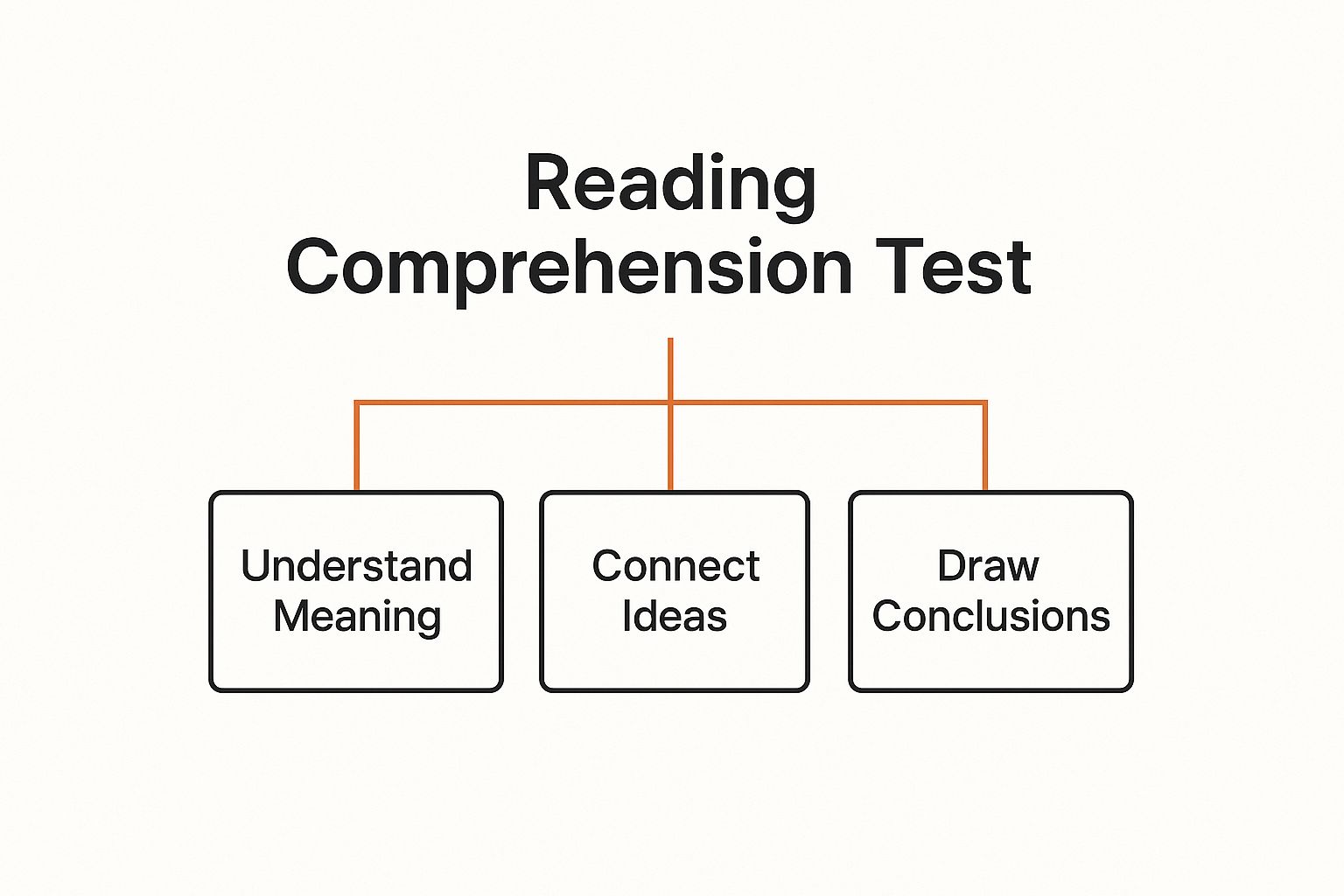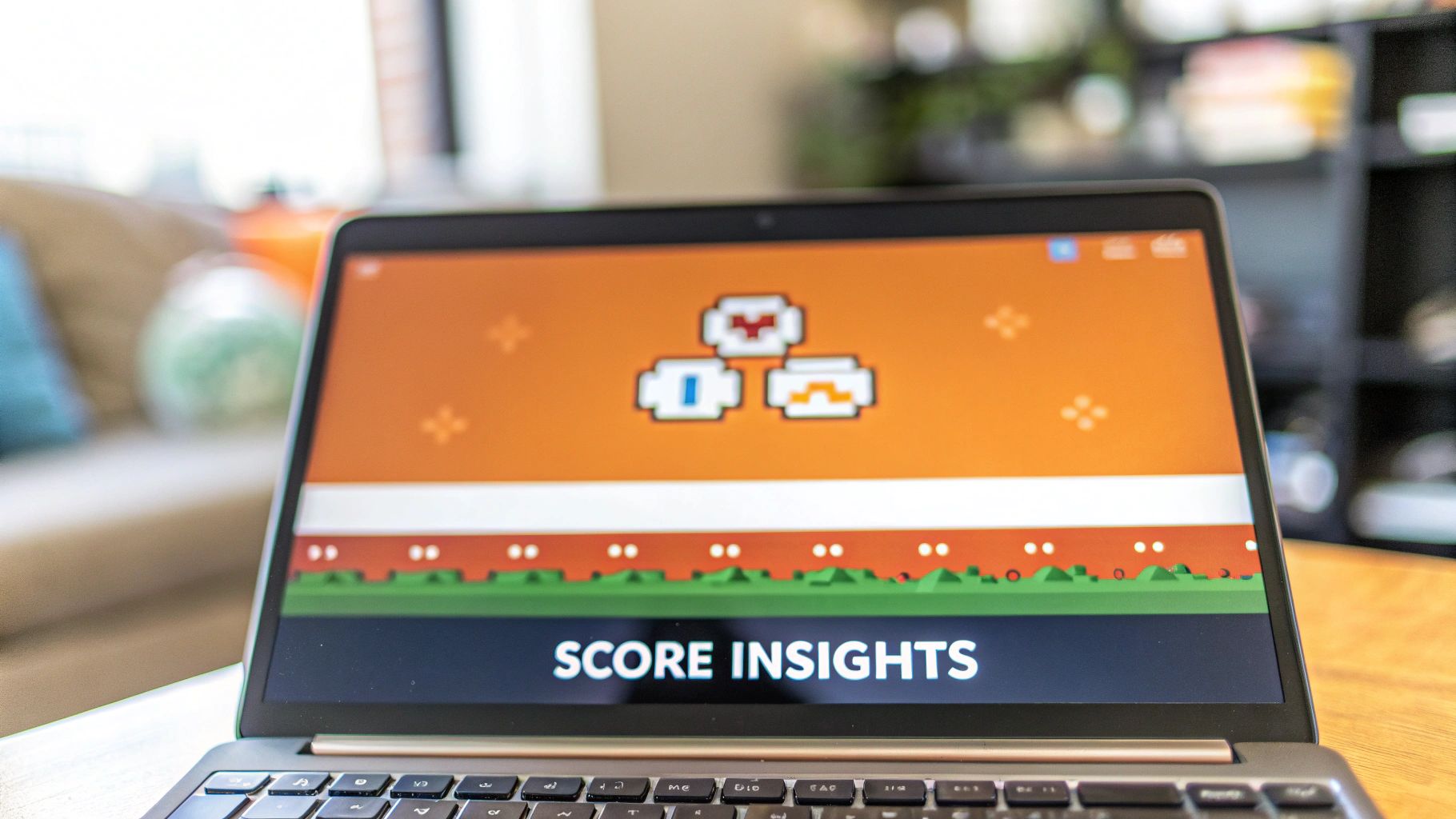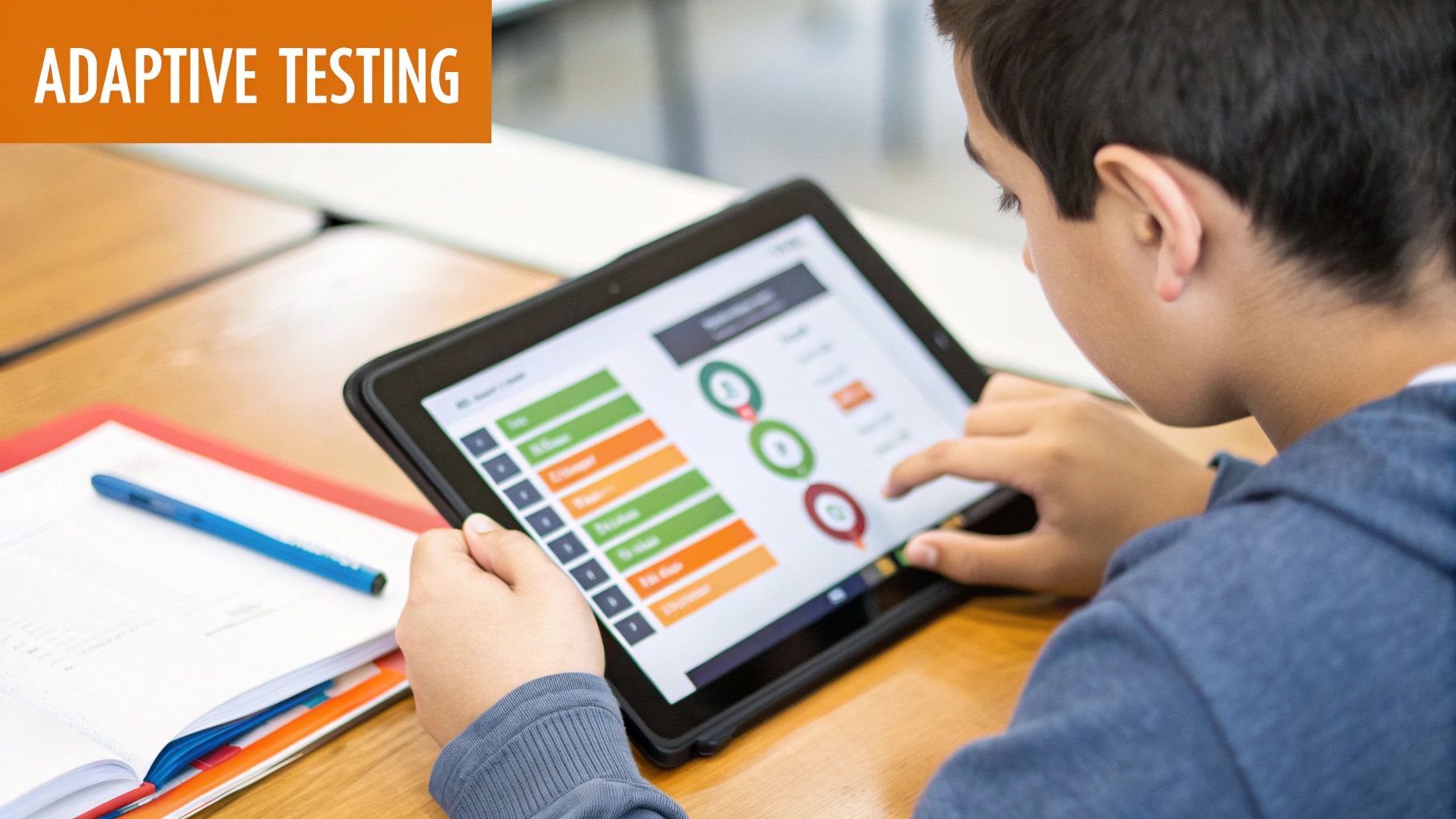Your Guide to a Test of Reading comprehension
Oct 9, 2025
A test of reading comprehension is an assessment built to find out how well you actually understand what you read—it goes way beyond just being able to sound out the words on a page. Think of it as a tool that measures your ability to grasp meaning, link ideas together, and draw solid conclusions from a text. This guide will provide practical examples and actionable insights to help you master these tests.
Deconstructing the Test of Reading Comprehension
A reading comprehension test isn't just a spelling bee. It's more like a detective's case file, where you have to sift through clues within a passage to piece together the whole story. It digs into the deeper cognitive processes at play. To really get a handle on these tests, it helps to first understand the core skill of reading itself.
These assessments are a go-to for a whole range of professionals. Teachers use them to spot students who might need a bit of extra support, and clinicians often include them when diagnosing learning challenges like dyslexia. At the end of the day, the goal is always the same: get a clear picture of how well a reader can process and make sense of new information.
What These Tests Truly Measure
It's a common mistake to think these tests are all about memorizing and spitting back facts. The truth is, they're designed to evaluate a whole pyramid of skills, from the most basic to the most complex.
This infographic breaks down what a test of reading comprehension is really looking for.

As you can see, real comprehension means understanding what’s stated outright, weaving different ideas from the text together, and then using that information to make educated guesses or inferences. It shows how the simpler skills form the foundation for higher-level thinking. Getting this is the first real step to becoming a stronger reader.
A test of reading comprehension is a snapshot of how a reader interacts with a text. It reveals whether they are a passive consumer of words or an active participant in constructing meaning.
For example, a test might give you a short passage about photosynthesis and then ask you to do any of the following:
Pinpoint the main idea by asking, "Which sentence best summarizes this paragraph?"
Figure out the author's tone by asking if the text is meant to be informative, persuasive, or entertaining.
Predict what might happen next based on clues in the text, such as, "Based on the text, what would happen to a plant if it received no sunlight?"
Each of these tasks taps into a different level of thinking, which helps paint a detailed picture of a reader's strengths and weaknesses. The table below outlines these core skills with actionable examples.
Core Skills Measured in Reading Comprehension Tests
This table breaks down the fundamental abilities that a test of reading comprehension is designed to evaluate, from basic recall to complex analysis.
Skill Assessed | What It Measures | Example Task |
|---|---|---|
Literal Comprehension | Your ability to recall facts and details that are explicitly stated in the text. | "According to the passage, what year did the event take place?" |
Inferential Comprehension | Your ability to read between the lines, understand implied meanings, and draw conclusions based on textual evidence. | "Why do you think the main character decided to leave?" |
Vocabulary in Context | Your ability to determine the meaning of a word based on the surrounding sentences and the overall topic. | "In this context, what does the word 'ephemeral' most likely mean?" |
Main Idea/Summarization | Your ability to identify the central theme or most important point of a passage and condense the information. | "Which of the following sentences best summarizes the paragraph?" |
Author's Purpose & Tone | Your ability to recognize the author's reason for writing (to inform, persuade, entertain) and their attitude. | "What is the author's primary purpose for writing this article?" |
Critical Analysis | Your ability to evaluate the text, distinguish fact from opinion, and analyze the author's arguments. | "Does the author provide sufficient evidence to support their claim? Explain." |
As you can see, it's a multi-layered process. You can dive deeper into the intricate cognitive steps involved by exploring our guide on the reading process and timing. This kind of insight is invaluable for anyone looking to improve their reading or get ready for an assessment.
Navigating Common Test Formats
Knowing what a test of reading comprehension is actually trying to measure is one thing, but getting comfortable with what it looks like in practice is the next crucial step. These tests aren't one-size-fits-all. They come in several flavours, each designed to poke and prod at your understanding in a slightly different way.
Getting a feel for what’s coming can seriously cut down on test-day jitters and help you show what you really know.
The format most of us know best is multiple-choice. You read a passage, and then you’re asked to pick the best answer from a few options. It sounds simple, but the real trick is often spotting the difference between a pretty good answer and the best one. Actionable insight: Before looking at the options, try to answer the question in your own words. This helps you avoid being misled by tempting but incorrect choices.
For instance, after a paragraph about the migration of monarch butterflies, you might see a question like this:
Which of the following is the primary reason for the butterflies' journey? A) To find brighter flowers B) To escape cold weather and find food C) To meet other butterflies D) To find taller trees
Here, option B is the most complete and accurate choice you'd likely find in the text.
Beyond Multiple Choice
Another common type you'll run into is the cloze test. This is where you get a passage with certain words missing. Your job is to fill in the blanks with words that make sense. This directly tests your knack for using context clues to grasp the meaning and predict what should come next. Actionable insight: Read the entire sentence or even the whole paragraph before filling in a blank. The surrounding words provide critical clues to the correct answer.
You can see how standardized testing has shifted over the years, bringing in more complex formats like these.

This image shows the change in California's state testing, moving away from simpler questions toward assessments that demand much deeper, more analytical thinking.
Formats Requiring Deeper Analysis
Finally, some tests will throw short-answer or essay questions your way. These require you to build a response from scratch, showing what you understood in your own words. You might be asked to summarise a text, compare two different characters, or pick apart an author’s argument. This approach gives a much richer look into a reader's actual thought process. Actionable insight: Start by creating a quick outline. Jot down your main point and two or three supporting details from the text. This organizes your thoughts and ensures your answer is well-supported.
When you're dealing with different test formats, it helps to understand principles like Cognitive Load Theory. The goal is to make sure the test is truly measuring reading skills, not just how well someone can juggle a confusing format. By getting familiar with these different styles, you can walk into any reading comprehension test feeling much more prepared and confident.
How These Tests Are Used in the Real World
Far beyond the classroom walls, a test of reading comprehension becomes a powerful tool with a very real impact. We're not just talking about grades here; these tests are diagnostic instruments. They help educators and clinicians get a clear picture of how a person is processing written information, which is the first step toward providing targeted support that can completely change a person's learning journey.
Think of it this way: these assessments provide the objective data needed to move from just noticing a struggle to actually understanding its root cause.
In schools, these tests are absolutely essential. They flag students who might need a bit of extra help, making it possible for early intervention before a small challenge snowballs into a major roadblock. The results give teachers the insights they need to tailor their instruction, making sure every student gets the specific support they need to really thrive.
From Classroom Insights to Clinical Diagnosis
Let's imagine a student named Alex. He’s bright and well-spoken, but his written assignments are a constant struggle. A standard classroom test might show that while Alex reads words fluently, he has a tough time answering questions about the main idea or the author's purpose. This simple assessment is the first critical step.
Armed with this data, Alex's teacher can take immediate action. For example, she can provide Alex with a graphic organizer—a simple worksheet with boxes for "Main Idea" and "Supporting Details." This tangible tool helps him visually map out the text's structure, turning an abstract concept into a concrete task. In more complex cases, these same findings might signal that it's time for a more thorough clinical evaluation.
A reading comprehension score isn't a label; it's a compass. It points educators and specialists toward the precise area where a learner needs guidance, ensuring that support is effective and efficient.
In a clinical setting, specialists use a test of reading comprehension as one piece of a larger puzzle to diagnose learning disabilities like dyslexia. Understanding exactly how someone processes language is key, and these tests offer detailed insights into specific cognitive functions.
For instance, some reading difficulties are actually tied to how the body and brain coordinate movement and planning. You can learn more about this fascinating connection in our article on reading difficulties and praxis). This shows how a seemingly simple reading test can be a vital component of a much bigger diagnostic picture.
Informing Broader Educational Policy
The data gathered from individual students doesn't just stay in one classroom. When brought together, these results paint a much larger picture of educational policy. Aggregated test results can highlight widespread trends, helping school districts and governments decide where to put their resources most effectively.
This data-driven approach ensures that funding for things like literacy programs and specialized teacher training goes exactly where it’s needed most. It’s about making smart, informed decisions that benefit everyone. The journey from a single student's test paper to system-wide educational reform really highlights the vital role these assessments play. They are catalysts for personalized support, clinical clarity, and smarter public policy.
Making Sense of Your Test Score

Getting a score back from a test of reading comprehension can sometimes feel like you're trying to crack a secret code. The numbers and unfamiliar terms might seem a bit intimidating, but they tell an important story about a reader's unique skills.
Learning to understand these scores is the crucial first step. It transforms them from a final grade into a powerful tool for growth.
The most basic metric you'll see is the raw score. This is simply the total number of questions the person got right. While it's easy to grasp, it doesn't offer much context by itself. Nailing 40 out of 50 questions sounds great, but what that really means hinges on how everyone else did on the very same test.
That's where percentile ranks come in handy.
Putting Scores into Perspective
Think of a percentile rank like a leaderboard in a video game. It doesn't just show your personal score; it shows exactly where you stand compared to every other player. A score in the 75th percentile means the test-taker performed better than 75% of the other people in the standardized comparison group. It’s a fantastic way to put a single performance into a much bigger picture.
A single test score is just a snapshot in time, not the whole movie. It provides a valuable piece of the puzzle, but it should always be considered alongside classroom work, teacher observations, and a reader's overall engagement.
Another common metric you might encounter is the grade-level equivalent. A score of "4.2," for instance, suggests a student is performing at a level expected in the second month of the fourth grade. This number, however, can be a bit misleading and should be handled with care.
A younger student scoring at a higher grade level doesn't automatically mean they're ready for that curriculum. It just means they've mastered the specific skills being tested for their own grade.
Using Scores as a Guide for Growth
At the end of the day, the real purpose of any assessment is to get information we can act on. Once you have a handle on what the score means, you can start asking the right questions:
What specific skills were a bit tricky? Was the hang-up with vocabulary, making inferences, or finding the main idea?
Where are the areas of strength? Recognizing what a reader already does well is just as important for building confidence.
What are the next steps for support? The results can point you toward targeted practice. For example, if "vocabulary in context" was a weak area, you can make it a daily habit to look up one new word and use it in a sentence.
A detailed report from a test of reading comprehension is really just a starting point for a conversation about a learner’s needs. For a deeper look into what these kinds of evaluations can tell us, you can learn more about different cognitive assessments and how they build a complete picture of a learner's profile.
Remember, these scores aren't final verdicts. They are roadmaps, pointing the way toward stronger, more confident reading skills.
What State-Level Data Reveals About Reading Skills
When your child takes a test of reading comprehension, their score is more than just a personal number. Think of it as a single pixel in a massive, high-resolution image. On its own, it’s just a dot. But when you pull back and look at thousands of these scores together at the state level, a clear picture of educational health begins to form.
This big-picture view is crucial. It shows us where we’re succeeding and, just as importantly, where we need to roll up our sleeves and get to work. For policymakers and educators, this data isn't just numbers on a spreadsheet; it's the map they use to navigate the complex world of literacy instruction and make smart decisions that affect millions of students.
Using a large, diverse province as an example brings this idea to life. Looking at province-wide data allows us to see how local students stack up against national averages and their peers across the country. This context is everything—it helps us understand if our teaching methods are effective and where achievement gaps are silently growing, demanding our attention. It turns individual test scores into a powerful tool for improving the entire system.
A National Perspective on Provincial Performance
This is where large-scale assessments like the National Assessment of Educational Progress (NAEP) come in. Often called "The Nation's Report Card," the NAEP provides a standardized yardstick that allows for fair, apples-to-apples comparisons between different provinces and educational systems. It’s this data that helps provincial leaders answer tough questions about where to invest resources, how to shape curricula, and what kind of training our teachers need most.
Let's look at California's reading proficiency, which has shown some stable yet concerning patterns. As of 2022, the data placed California 33rd nationally in reading proficiency among all states and Washington, DC. While the state did better than Texas, it trailed behind other large states like Florida and New York.
What’s really interesting is that California’s scores didn't change much from 2019, while the national average took a significant dip over the same period. It’s a complex story, and you can dig deeper into these student achievement trends in California.
State-level data helps connect the dots between what happens in the classroom and the broad educational outcomes we see across the country. It allows us to see not just how one student is doing, but how an entire generation of learners is progressing.
By studying these trends, policymakers can spot specific challenges and create programs to help close those stubborn achievement gaps. It’s a powerful reminder that when you or your child sit down for a test of reading comprehension, you’re contributing to a vital, ongoing national conversation about how we can best support every single student on their path to becoming a confident, proficient reader.
The Future of Reading Assessment Is Here

The days of the static, one-size-fits-all test of reading comprehension are numbered. Let's face it, that old paper-and-pencil format is quickly becoming a relic. We're now moving from those simple tools to dynamic digital platforms that give us a much sharper, more personalized picture of a reader’s actual abilities. This isn't just about trading paper for pixels; it’s a fundamental shift in how we understand and support literacy.
Think about it. Instead of forcing every student through the same rigid set of questions, modern tools can now adapt on the fly. Imagine a test that adjusts its difficulty in real-time. If a reader nails a question, the next one gets a little tougher. If they stumble, the test eases up, offering a simpler question to pinpoint their precise skill level. This makes for a far more accurate and less frustrating experience all around.
Beyond Testing to Active Skill Building
But here’s where it gets really exciting. The latest developments go way beyond just assessment. New platforms are now weaving testing together with targeted training, creating a seamless cycle of evaluation and real improvement. These tools don't just point out a reader's weak spots; they offer up interactive exercises and personalized feedback to actively build those skills.
This completely changes the game. A test of reading comprehension is no longer a final judgment but a starting point for genuine growth. For instance, a program might notice a student struggles with making inferences. It can then automatically serve up engaging, game-like activities specifically designed to strengthen that one skill. It’s a direct, actionable path forward for every single learner.
Digital assessment tools are moving the goalposts from simply measuring comprehension to actively cultivating it. They provide the data to understand a reader's needs and the resources to meet them, all within a single, integrated system.
The resilience students show in their reading skills, even through tough times, really drives home how vital effective measurement and support are. Take eighth graders in California, for example. Their reading comprehension scores held steady from 2019 to 2022, while the national average actually declined. This stability speaks volumes about the impact of focused educational strategies. You can dig into the data yourself by checking out California's student assessment results.
Feeling inspired by what's now possible? We invite you to explore the forward-thinking reading tools on our website, like ReadON. Sign up for our email newsletter to get actionable tips and stay ahead of the curve in literacy development.
Your Questions on Reading Comprehension Tests Answered
Let's face it, the world of reading assessments can feel a little confusing. Whether you're a parent trying to support your child, a student getting ready for an exam, or an educator working to interpret results, you’ve probably got questions. It's essential to get clear, straightforward answers.
This section tackles some of the most common questions we hear about the test of reading comprehension. We’ve gathered practical insights to help you feel more informed and confident. Let’s dive in.
How Can I Help My Child Prepare for a Test?
The best preparation has less to do with last-minute cramming and everything to do with building strong, daily reading habits. The real goal isn't just to pass a test, but to nurture a genuine love and understanding of texts. When that happens, better performance on any test of reading comprehension naturally follows.
A practical action you can take is to encourage your child to read a wide variety of things they actually find interesting—it could be anything from fantasy novels to online articles about their favourite video game. The key is what you do afterwards. Make it a habit to simply chat about what they've read.
A simple conversation can be one of the most powerful preparation tools you have. Asking, "What was the main point of that story?" or "Why do you think that character did that?" builds the active recall and critical thinking skills these tests are designed to measure.
Are Online Reading Comprehension Tests Accurate?
Yes, they absolutely can be, especially modern adaptive ones. An adaptive test adjusts the difficulty of questions in real-time based on a user’s answers. Practical example: If you answer a medium-difficulty question correctly, the next one might be harder. If you get it wrong, the next one will be easier. This quickly hones in on your precise skill level, making the test both efficient and highly accurate.
Of course, the accuracy all comes down to the quality of the test itself. Actionable insight: Look for assessments that have been developed by educational experts, are backed by solid research, and are transparent about how they measure skills.
What Is the Best Strategy to Improve My Own Comprehension?
One of the single most effective strategies is something called metacognition. It sounds complicated, but it just means "thinking about your own thinking" as you read. It’s the crucial difference between passively letting your eyes scan a page and actively wrestling with the material.
Here's an actionable way to practice this:
Before you read: Look at the title and headings. Ask yourself, "What do I already know about this topic?" This activates prior knowledge.
While you read: Pause after each paragraph and ask, "What was the main point here?" Try to summarize it in one sentence in your head.
If you get confused: Don't just push forward. Reread the confusing sentence. If there's a word you don't know, look it up. Acknowledge the confusion and actively fix it.
This active, self-monitoring approach trains your brain to process and hold on to information far more effectively.
Ready to move from questions to action? At Orange Neurosciences, we provide advanced, evidence-based tools that offer a clear picture of cognitive skills. Our assessments and training programs, like ReadON, are designed to give you the data-driven insights needed to support learners effectively.
Explore how our platform can help you understand and build stronger reading skills by visiting us at https://orangeneurosciences.ca. Sign up for our newsletter to receive more practical tips directly in your inbox.

Orange Neurosciences' Cognitive Skills Assessments (CSA) are intended as an aid for assessing the cognitive well-being of an individual. In a clinical setting, the CSA results (when interpreted by a qualified healthcare provider) may be used as an aid in determining whether further cognitive evaluation is needed. Orange Neurosciences' brain training programs are designed to promote and encourage overall cognitive health. Orange Neurosciences does not offer any medical diagnosis or treatment of any medical disease or condition. Orange Neurosciences products may also be used for research purposes for any range of cognition-related assessments. If used for research purposes, all use of the product must comply with the appropriate human subjects' procedures as they exist within the researcher's institution and will be the researcher's responsibility. All such human subject protections shall be under the provisions of all applicable sections of the Code of Federal Regulations.
© 2025 by Orange Neurosciences Corporation



